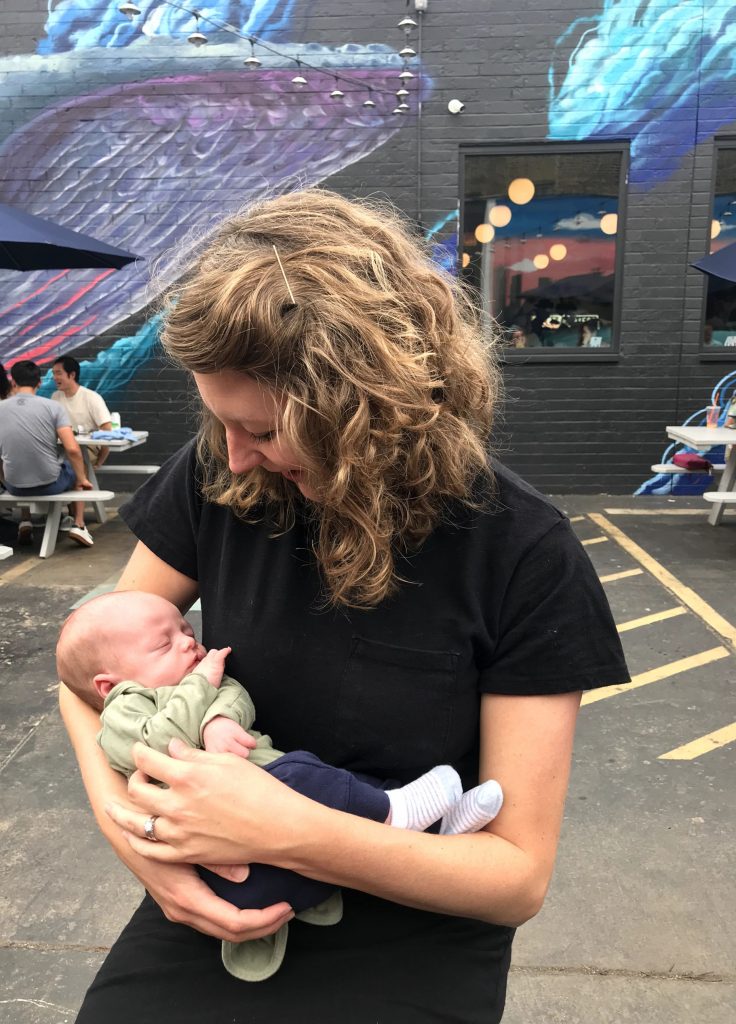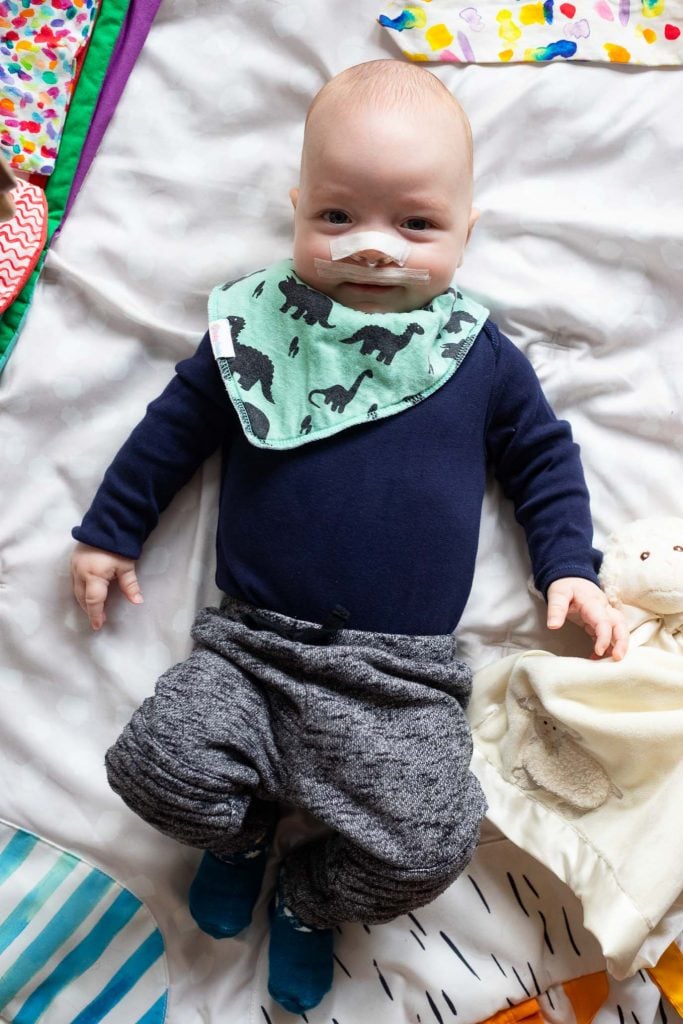Exclusive Pumping Tips and Tricks from a New Mom
8 min read
This post contains affiliate links. Purchasing via affiliate links supports Dietitian Debbie Dishes at no additional cost to you.
When I was in college studying to become a dietitian, we were always told that “breast is best” but there wasn’t much discussion about just how difficult breastfeeding can be for a new mom! The pressure to be successful with breastfeeding was overwhelming and it didn’t come naturally to me. My journey with breastfeeding looks completely different than what I imagined while pregnant. Now that I’ve been through the wringer, I have a whole new appreciation for “fed is best”.
Here’s a little bit of our journey and how I’ve ended up exclusively pumping. When I was struggling with breastfeeding, I found posts like this so helpful!
Our Journey with Exclusive Pumping
At my 20 week anatomy ultrasound, I found out that my son had a cleft lip/palate so I was expecting that I would likely need to pump my breastmilk. However, he surprised us all in the delivery room and was born with just a cleft lip. Since babies with just a cleft lip can sometimes successfully breastfeed I was excited to give it a try.
In the hospital, I saw a few lactation consultants who suggested I feed him with nipple shields since he wasn’t latching well without them. They also had me start pumping a few times a day while in the hospital to help my milk come in.
We continued with the nipple shields at home and I thought he was doing well until we had our first pediatrician appointment and found out he had lost more than 10% of his birth weight. I felt like such a failure since I wanted to exclusively breastfeed so badly, but we ended up needing to supplement with formula from the beginning. Looking back, I wish I could tell myself that there is no reason to feel guilty about needing to use formula. A fed baby is the goal, regardless of whether that is breastmilk, formula, or some combination of the two.
We also had a couple more lactation consults and recognized that Micah wasn’t very efficient at nursing even with the shields. It was exhausting to keep up the triple feedings (nurse + bottle feed + pump). Every feeding felt like a marathon and it was taking a toll on my mental health. I dreaded nighttime because we were getting so little sleep with these long feeding sessions.
Besides the cleft lip, Micah also had a tongue tie which we had corrected at one point during this process but he still wasn’t efficient when nursing but did fine with bottle feeding. In the end, I realized exclusively pumping was the easiest and least stressful option for both of us.

How to Maintain and Increase Your Breastmilk Supply
Before I starting this exclusive pumping journey, I thought that a huge freezer full of breastmilk was normal. It seemed like almost every mom talking about breastfeeding or pumping online had huge supplies of milk so I was surprised when I was making just enough to keep up with my baby’s needs. I thought something was wrong with me since I couldn’t make enough to stash away until I found out later that the giant freezer stash isn’t the norm! For a few weeks, I did struggle to keep up with the amount of milk that Micah needed so we supplemented with the occasional bottle of formula until my supply increased.
Those couple of weeks when I was desperate to increase my milk supply, I tried so many of the suggestions offered online. A lot of them didn’t really seem to make a difference, but these were the ones that I found most helpful:
- Keep up with your pumping schedule: Keeping up with a good pumping schedule is essential as the amount of breastmilk you make is based on supply/demand. The more regularly you pump, the more signals you send to your body to produce milk and increase your supply.
- Hydration: You fluid needs increase to 3.8 liters (~16 cups!) per day when breastfeeding so drink up momma! Water isn’t the only thing that counts towards that 16 cup goal – any fluids, soups, etc, count.
- Eating Enough: It can be hard to find the chance to feed yourself with a newborn, but it is so important to eat well to maintain your milk supply. You need an extra 500 calories a day for breastfeeding so I found keeping some extra snacks on hand helps.
- Power pumping: This is essentially how you mimic a cluster feeding while exclusively pumping and it really seemed to help me!
- Multiple Letdowns: Use the two different settings on the pump to stimulate more than one letdown a session. I usually do 2-3.
This exclusive pumping blog was really helpful in figuring out my schedule, power pumping, and more. I also found Karrie Locher’s instagram account really helpful too.
Foods that May Help Support Breastmilk Supply
Unfortunately, there isn’t a lot of strong research on foods that may increase your breastmilk supply. However, there are a few foods known as galactogogues that may or may not help. (Results seems to vary a lot person to person!) Regardless, the most common lactogenic foods are also super nutrient dense, so it wouldn’t hurt to incorporate them into your diet more often postpartum.

Pros and Cons of Exclusively Pumping
- Pros of Pumping:
- Gives you the option of still providing breastmilk to your baby even if they have difficulty latching/nursing.
- You know exactly how much milk you are producing.
- You can track just how much milk your baby is drinking.
- Partner can help with feedings.
- Freedom to leave the house or return to work and still provide breastmilk to your baby.
- Cons of Pumping:
- Constantly having pump parts and bottles to wash
- Pumping doesn’t have the same special bonding effect that nursing does.
- More expensive since you need to buy pump parts/bottles/etc.
- Feeling stuck while you are attached to a feeding pump near an outlet.
Sample Exclusive Pumping Schedule
A huge thanks to the speech patho
logist/lactation consultant I saw a week or two after Micah was born for helping us figure out a feeding/pumping schedule. Here is what my schedule looked like:
| 0-2 Months | 2-3 Months | 3 Months | 6 Months | 8 Months |
| 3 AM 6 AM 9 AM 12 PM 3 PM 6 PM 9 PM 12 AM |
2 AM 6 AM 9 AM 12 PM 3 PM 6 PM 9 PM |
5 AM 9 AM 12 PM 3 PM 6 PM 9:30 PM |
5 AM 9 AM 1 PM 5 PM 9 PM |
5 AM 10 AM 3 PM 8:30 PM |
Those first 6-8 weeks, I was waking up twice a night to pump in order to establish my supply. Since I was pumping, my husband helped feed Micah overnight. I eventually dropped the midnight pumping session at around 8 weeks. Finally, at around 12 weeks I dropped the nighttime pump all together. Now that I am back to work, I’ve dropped down to 5 pumping sessions a day. I usually pump for about 25 minutes at each session.
Since you’ll need to pump so frequently in those early days, buy a few sets of pump flanges/bottles/parts so you aren’t washing the same set every time! I ended up buying 3 sets to help cut down on how often I was washing everything. For cleaning, I use a basin we were given at the hospital for cleaning pump parts in the beginning. You want to avoid cleaning your pump parts directly in the sink. Here’s a guide from the CDC with cleaning tips.
Tips for Pumping at Work
My workplace has a generous leave policy for new parents, so I was able to take about 4 months of leave with Micah. (I wish all US parents had this!) Thankfully, that allowed me enough time to fully heal from birth and establish a good pumping routine. One of the benefits of exclusively pumping is that Micah was already used to taking milk in bottles so I didn’t have worry about bottle rejection at daycare. Here are a few tips that have helped keep me sane as I returned to work as a pumping mama.
- Invest in a larger bag for work because you need to carry a lot more stuff! I didn’t want to carry a separate bag for my pump and bottles, so I just use the extra large diaper bag I bought. I love this bag. (I’m wearing it in the photo below!)
- Refrigerate your pump parts between pumping sessions. Unless your baby is immunocompromised, it is generally recognized as safe to store your pump accessories in the fridge. This was a lifesaver since I didn’t have a good space for washing my pump parts at work. I just put everything in a large stasher bag.
- Get a car adapter or battery operated pump to sneak in pumping sessions in the car. My commute is around 40 minutes so it was the perfect amount of time to get in another pumping session during the day.

Favorite Breastfeeding Products
- Ameda MyaJoy Breast Pump: This is the breast pump that was provided through my insurance at work and so far it has worked well for me. I love how compact it is, but still seems to have lots of power. It does have a battery so you aren’t stuck by a plug but it drains the battery fast so I usually can only get 1 pumping session out of it. (I just put it in a fanny pack if I want to be able to move around while pumping.)
- May Mom Flanges: Having the right size flanges is really important for getting milk out of your breasts effectively. I had to buy a different size than the standard ones that came with the pump. A lactation consultant can help you measure and make sure you get the right fit.
- Earth Mama Nipple Butter: I put this on before I pump and it has been a lifesaver!
- LaVie Lactation Massagers: These are great for helping work out clogged ducts and faster milk removal.
- Kindred Bravely Pumping Bra: The band size tends to run smaller than their size guide so I would size up. These bras are the most comfortable and do the best job of holding the breast pump flanges in place for hands free pumping. They are the only ones I wear!
- Phillips Avent Bottles: We started using these wide nipple tops after Micah’s speech pathologist recommended them and he’s done so well with them! We started with a package of 4 ounce bottles and bought larger bottles as he started to drink more.
- Huckleberry App: We use this app to track everything from feedings to sleep. It also has the option to track your how much you are pumping so you can monitor your output and compare to how much baby is eating.





